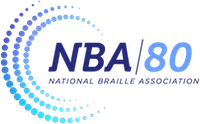Kathleen
Forum Replies Created
-
AuthorPosts
-
Kathleen
ModeratorI think what you've described doing sounds right. If the words are different I would probably put each Volta on a separate parallel but if they are the same, it's usually clear enough to put them on the same line. I think the main issue is clarity - if you feel that doing B) above is clear and the music is straight-forward then it should be good. If it at all seems unclear as you are proofing it, it's probably best to braille each Volta separately, as in A).
Hope that helps!
Kathleen
ModeratorYes, these should be all done in music braille.
Kathleen
Kathleen
ModeratorThis is indeed a very odd diagram. It's not like any fingering chart I've come across. I might try and do some sort of tactile representation or something. Or use a full cell for dark circles and dots 1346 for an open circle.
Kathleen
Kathleen
ModeratorThat's a new one for me. I'm not sure what the print is asking for, so I would follow print exactly as it appears. I'd most likely omit the empty staff and just make it a list.
Kathleen
ModeratorI think that is a transcriber choice. I generally do not use the superscript indicator. I just braille "Io"
I don't use the small circle or degree sign since, yes. It is the letter o and not a zero or just a circle.
Kathleen
ModeratorOh that's a very good question. That has been left off the list. I consider it akin to an ornament. Something that affects the way we play the note or approach the note. So I would put it before a nuance but after a down-bow or mute sign. If there is an ornament as well, I would put the shape sign before the ornament.
Kathleen
ModeratorHi Anna,
I'm curious as to why you think you couldn't do the chords with bar-over-bar format. That is how I would approach it. Take the guidance from the Section 29.17 in MBC2015. Chord symbols can easily go beneath the parallel.
Hope that helps!
Kathleen
Kathleen
ModeratorThe proper order would be:
word-sign expression - position - up bow - octave indicator - note - fingering
Check out the new DeGarmo Introduction to Braille Music 3rd edition for a nice new updated General Order of Signs in the Appendix.
Available here: https://nfb.org/programs-services/braille-certification/music-braille-transcribing
Kathleen
ModeratorHere is Mr. Owens' response
see attached pdf
Attachments:
You must be logged in to view attached files.Kathleen
ModeratorSorry I don't think the simbraille worked for some reason. Here's a pdf of the braille Mr Owens sent per your question.
Attachments:
You must be logged in to view attached files.Kathleen
ModeratorHi Robert,
Here is the response from Mr. Owens:
Yes plectrum strokes can be doubled as in MBC.
However in the example used the alignment should appear as below:
#G C--D-EL L EMDL- L EL-FM-
<B<B?? ? ? L ? ?N L ?? ??
,G ,C ,G
#AJ FLE-FMDL
? ? ? ?@C
,D ,G
If you look at examples 9.lj & k you'll see an example of proper alignment. Example 9.11 has an error as the lines of the parallel should be shifted 1 space to the right.
Also notice that at the end of measure 10 there is a slide rather than a shift. Which slide you use depends on whether you're sliding into another note, plucking or not plucking the 2nd note or sliding out of a note.
These are the sort of things we need to look at for further explanation so I welcome any questions and/or suggestions in order to make this as clear as possible.
Kathleen
ModeratorI just replied to your other post about tablature! If you want to use the new system just published, you can find it under the Resources tab above. Be sure to discuss it with your client and give them access to the Code as well, so they know how to read it once you've transcribed it.
Kathleen
ModeratorUnder the Resources tab above, you can download the new Owens System of Braille Tablature if you would like to use it for your tablature transcription!
Be certain that you send your client a link to the document as well, so that they will know how to read it. Also be sure YOU understand it well enough to transcribe it well!
Kathleen
ModeratorHi Robert,
I would not do it as you've done in the example. Single-line format should be single-line, not two lines like that. I would just braille it as you would any other piece. Intervals are read upward in the bass clef, so when the octave intervals begin, you'd braille the 2nd octave G with a doubled octave interval after it. The directions tell the reader what they need to know. No reason to add parentheses that aren't there in print or make it more complicated than it needs to be!
Kathleen
ModeratorQuite honestly, I have no idea to what these numbers are referring. Is there any guidance from the text? Preface material? Is this a method book?
I think the way you have handled it is pretty good. The only thing different you need to do is precede the negative numbers with a word sign indicator. Otherwise they don't read as numbers, but as some strange combination of intervals. I also don't think you need all the music asterisks nor the music parentheses. One TN at the first instance would suffice, explaining how you are treating the numbers. After that, they should be aware of them as they come along. But you definitely need the word sign indicators before each one.
Hope that helps!
Kathleen
-
AuthorPosts
